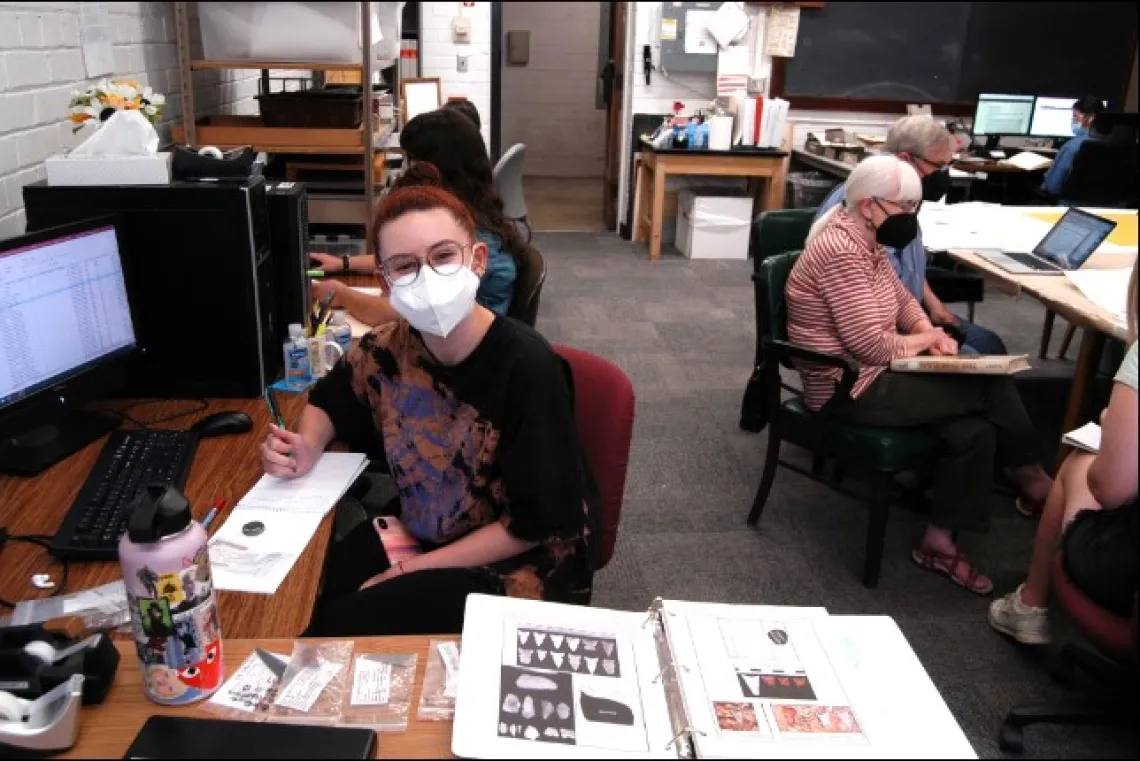
Stella Douglass writing a description of a catalog object from the University Indian Ruin Field School collection.
By Stella Douglass
ASM Archaeological Repository and School of Anthropology BARA Intern
Spring 2022
As someone whose studies focus mainly on Art History, with specific interests in contemporary art and architecture, it is safe to say that I am surprised that participating in an internship at the Arizona State Museum (ASM) would garner a host of new experiences for me. I was initially interested in interning to learn more about museum work and repatriation, having been able to visit the amazing exhibitions at ASM before and during the COVID-19 pandemic. This semester I was given the opportunity to intern at the ASM Repository and aid both the bulk collection and cataloging process of the University Indian Ruin (UIR), AZ BB:9:33(ASM), in a collaborative program between the University of Arizona School of Anthropology, Bureau of Applied Research in Anthropology, and ASM.
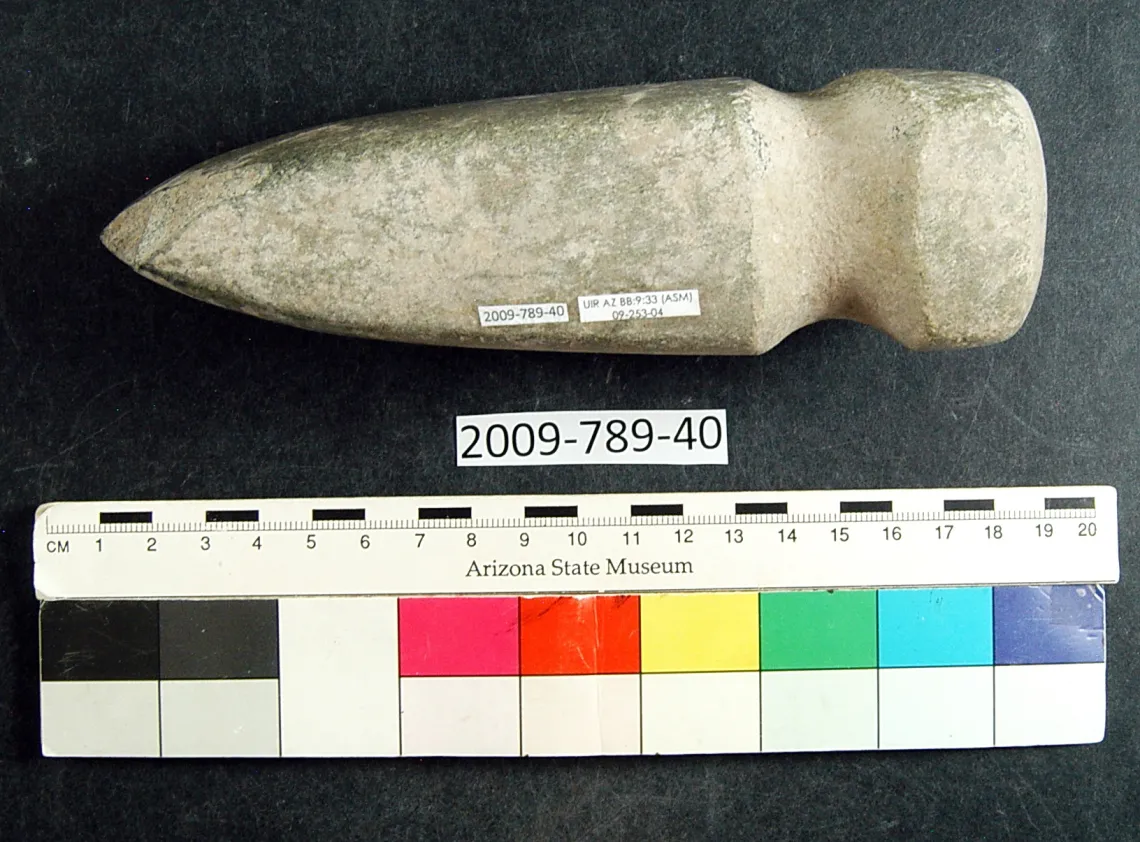
2009-789-40: A three quarters grooved axe made from a fine-grained diorite.
UIR is a Classic period (1150-1450 CE) Hohokam site located to the east of downtown, near the confluence of the Pantano Wash and Tanque Verde Creek. The site contains a platform mound, a structure the Hohokam utilized to elevate certain community structures (Fish et al 2015). This site was dug as part of a field school from 2010-2013. Getting the artifacts and documentation from this field school ready for in-perpetuity curation was the focus of this internship. The first segment of my semester with ASM was spent going through the bulk collection boxes, a process that was already well established prior to my arrival. This task, while seemingly simple, was essential in ensuring that the information in the database matched with the physical objects in our possession. There were many times where our team found some discrepancies between the boxes and the databases, requiring a certain amount of problem solving to hunt and retrieve objects. Our lovingly named “Voldebox”, also known as the Problem Box, housed the objects that needed further clarification on provenience. The bulk collection consisted of over 3900 bags of items including groundstone, flaked stone, chipped stone, faunal, shell, pollen, obsidian, ceramics, historic artifacts and more. Through this process I was able to become at least visually familiar with a wide range of object types.
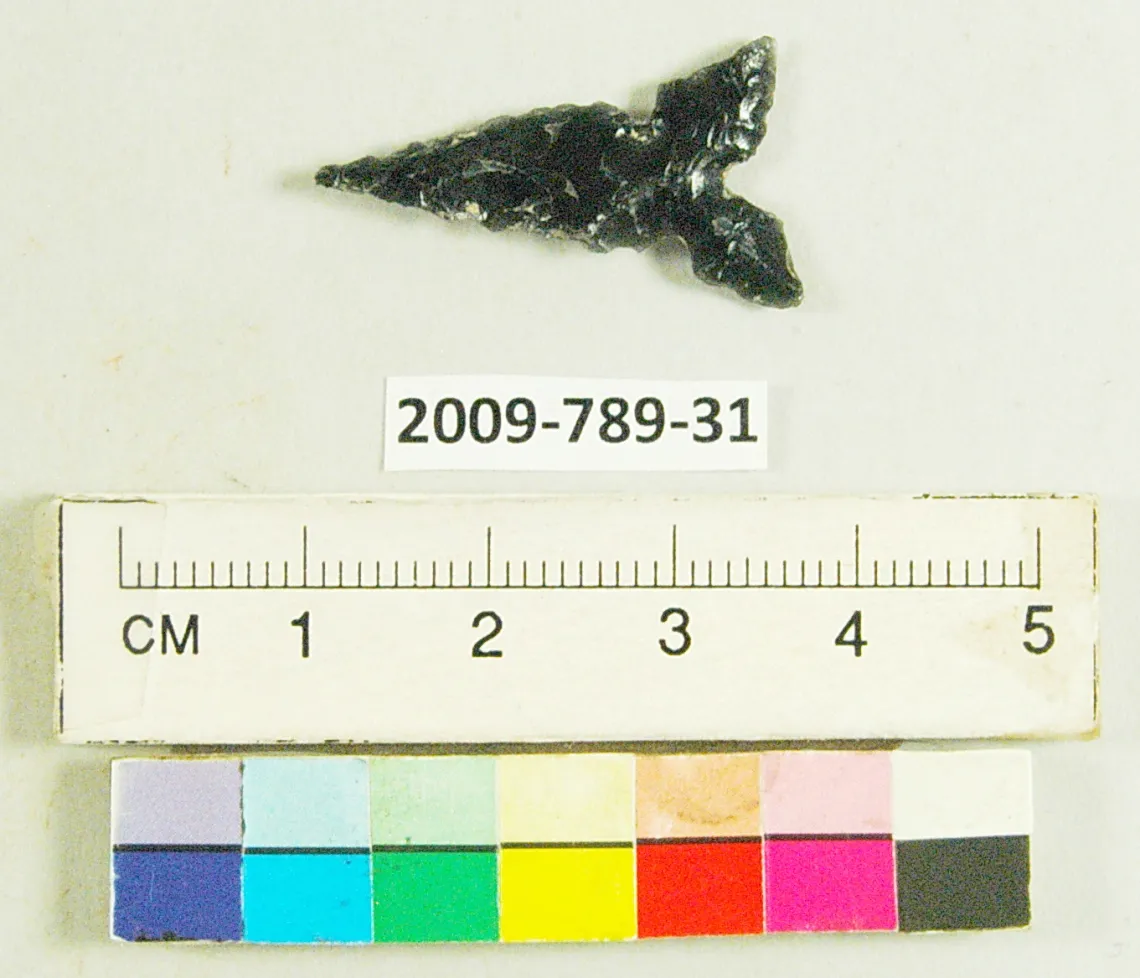
2009-789-31: This object is a small, complete, obsidian projectile point. The artifact has parallel C-shaped notches. The basal edge is concave with a C-shaped basal notch.
My remaining time was spent preparing the UIR catalog collection for in-perpetuity curation. I was assigned objects 2009-789-30 through 2009-789-49, a wide spectrum of objects that I was responsible for labelling with their ASM catalog number, photograph, and write catalog card descriptions. The cataloging process clearly focused on a very small portion of the objects from UIR, but it required hours of additional readings and talking with Drs. Suzanne and Paul Fish, Stacy Ryan, Dr. Katie MacFarland, and Dr. Katherine Dungan in order to gain a basic understanding of how to describe them in a manner fit for a catalog card.
My favorite part of the cataloging process was photographing the catalog objects I was assigned. Photographing the objects allowed me to get up close and personal with the object as I had to choose the appropriate background and lighting for each one. To me, this process, as well as that of editing the photos, was a time when I could involve slightly more creativity. From projectile points to ceramic sherds to axe heads to pendants, there was no shortage of excitement.
I took a particular interest in the lithics, especially the 3/4 grooved axe head (2009-789-40) and complete obsidian projectile point (2009-789-31). The axe was made from a fine-grained diorite and has been ground to become totally smooth on almost all surfaces. The butt of the axe has been heavily battered, and the toe of the axe has a large chip missing. This could suggest that the butt of the axe was also used as a hammer.
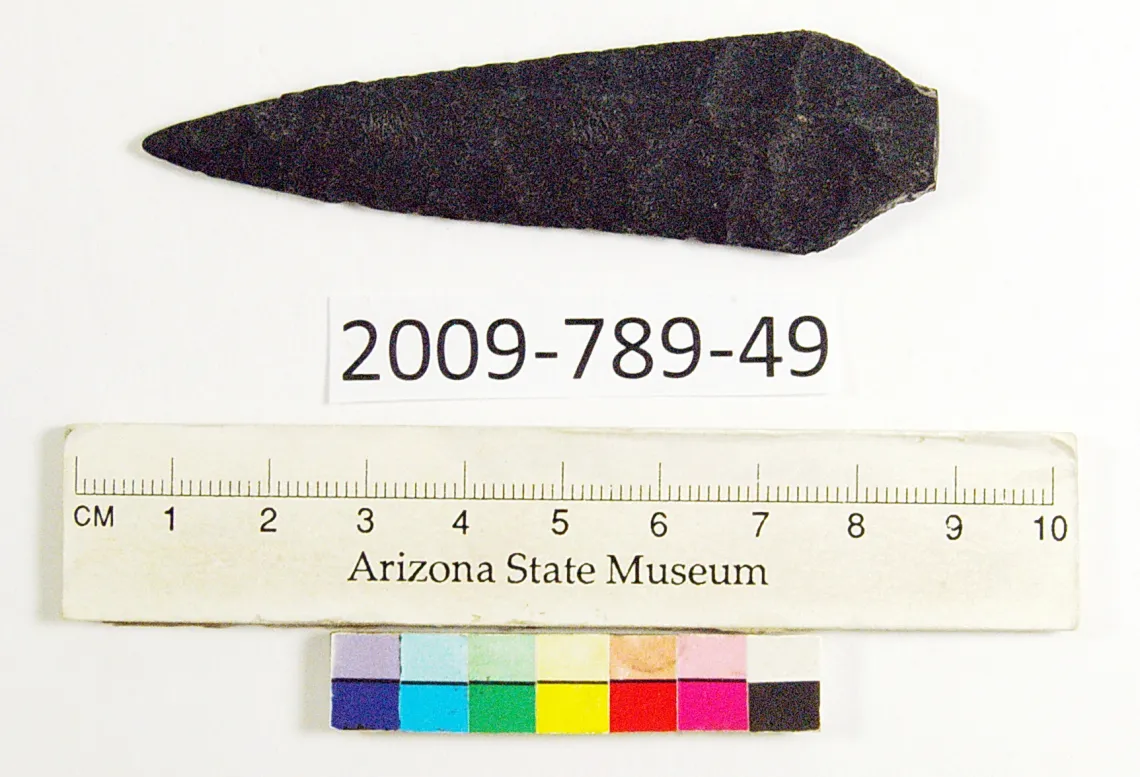
2009-789-49: A bifacially worked projectile point preliminarily classified as an Empire type from the San Pedro or Cienega phase (Sliva, 2009).
This obsidian projectile point is a complete point with pointed ears and parallel C-shaped side notches. 2009-789-31 closely resembles Deni Seymour’s Ancestral Apachean/Cerro Rojo classification (Seymour, 2017). In order to properly describe the projectile points I researched a variety of types and classifications, a process that I enjoyed immensely. The technique and care that goes into creating these points astounds me, especially considering some of them are incredibly small, this example only being 2.66 centimeters in length.
Interestingly, there is another projectile point (2009-789-49) that is not from the Classic period, but is dated to almost 1000 years prior to the primary occupation of the site. 2009-789-49 is a projectile point dated to 200-300 CE by Drs. Suzanne and Paul Fish, tentatively classified as an Empire point of the Cienega or San Pedro phase. The point has flake scars that have been rubbed after shaping, in an attempt to smooth and/or erase them. The presence of this point at the UIR site could indicate that the Hohokam were interested in the points of other cultures and that they potentially collected them as special objects.
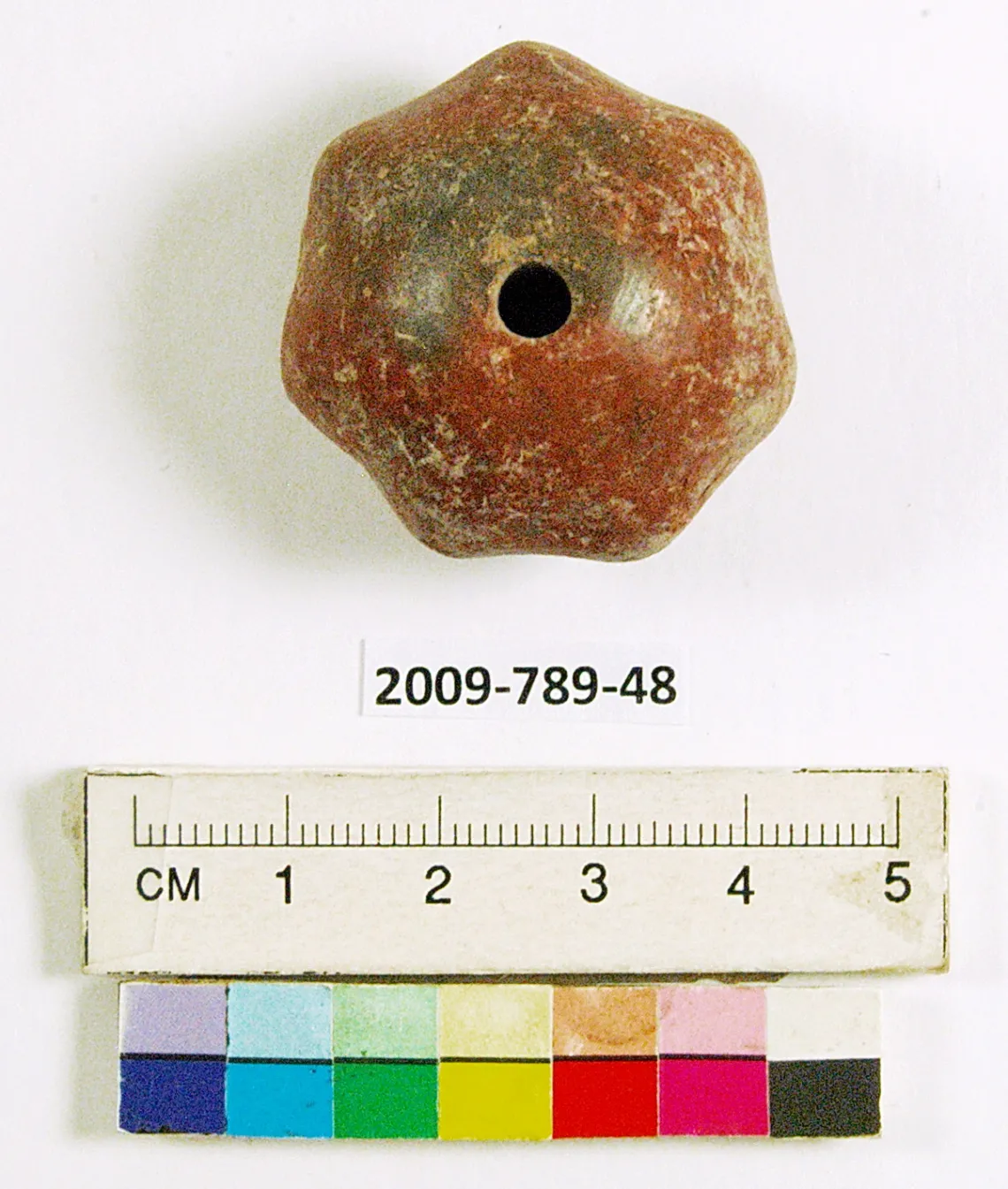
2009-789-38: A ceramic spindle whorl. This object is in a disc shape with a central perforation.
While I was particularly enthusiastic about the lithics, a heptagonal spindle whorl made from polished red ware (2009-789-48) also caught my eye. According to the Fishes, this style of spindle whorl is characteristic of West Mexico, a great distance from the UIR site in Tucson. The characteristic of a spindle whorl can change depending on the material being spun, which might explain the difference in the two spindle whorls that were part of my catalog section. In contrast to the polished red ware spindle whorl, 2009-789-38 is a more expedient and typical example. This object is more disk-shaped and was likely made from what was once the base of a pot or bowl. A remnant sherd from a ceramic vessel was refurbished into the spindle whorl, leaving smudgy residue that can still be seen on one side of the spindle whorl.
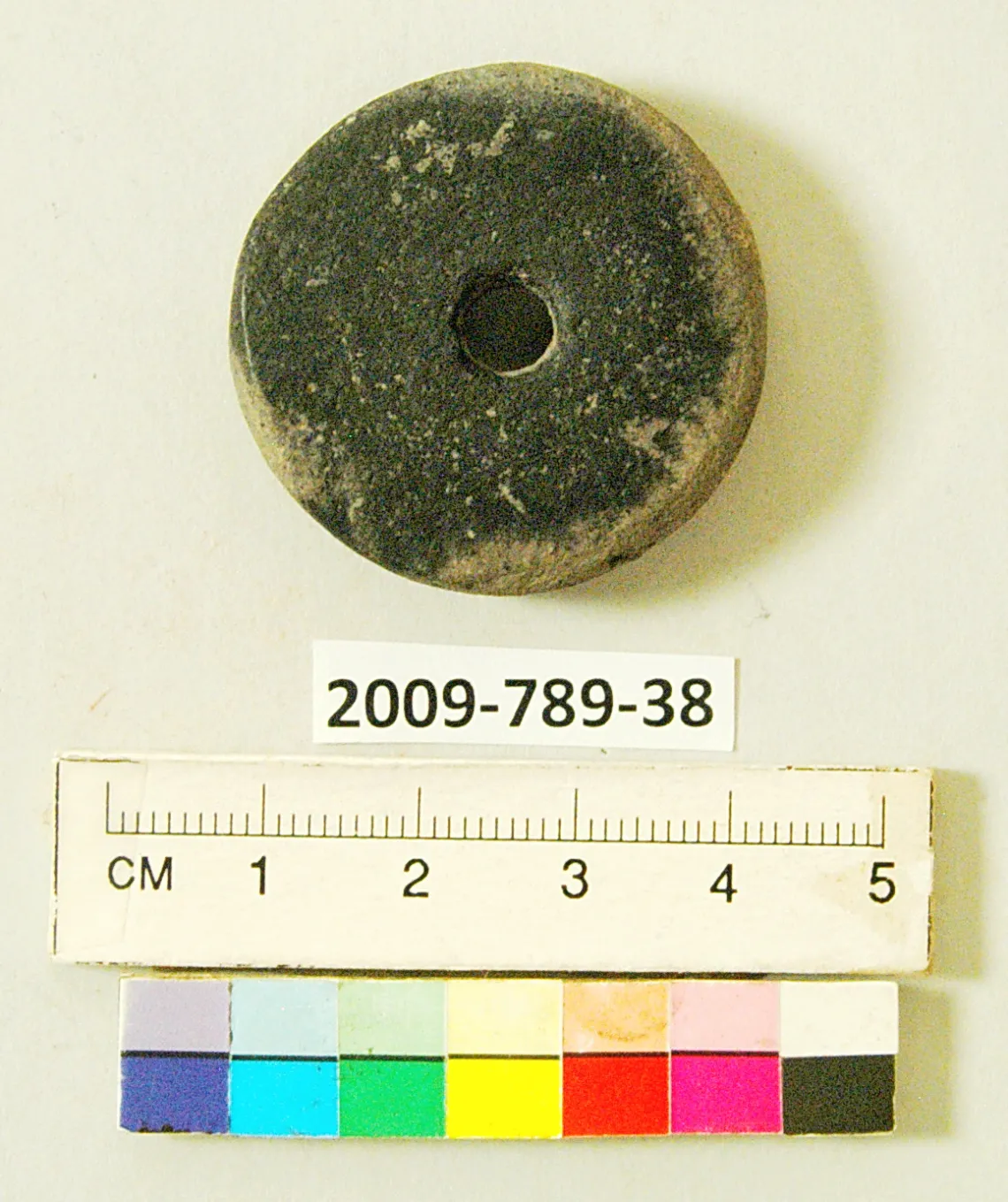
2009-789-38: A ceramic spindle whorl. This object is in a disc shape with a central perforation.
Apart from the seemingly exponential growth in my knowledge about the cataloging process, I am extremely grateful for the opportunity to learn from Dr. MacFarland, Dr. Suzanne Fish and Dr. Paul Fish, and the Repository staff. Their willingness to help me by answering my never-ending amount of questions and guiding me through the bulk and cataloging processes is something that I deeply appreciate. Collaboration and communication were two of the most essential skills needed during my time at ASM as it would be impossible to learn and grow without the help of those around me. The Arizona State Museum Repository is filled with both amazing people and collections, and I am lucky to have had the opportunity to intern here for the last semester.
References Cited
Seymour, Deni
2017 Protohistoric Projectile Points and other Diagnostics: A Pan-regional Southern Southwestern Perspective, Journal of Arizona Archaeology 2017, Volume 4, Number 2:132-149
Fish et al
2015 University of Arizona Archaeological Field School University Indian Ruin Preliminary Report, 2010-2014, School of Anthropology, University of Arizona





